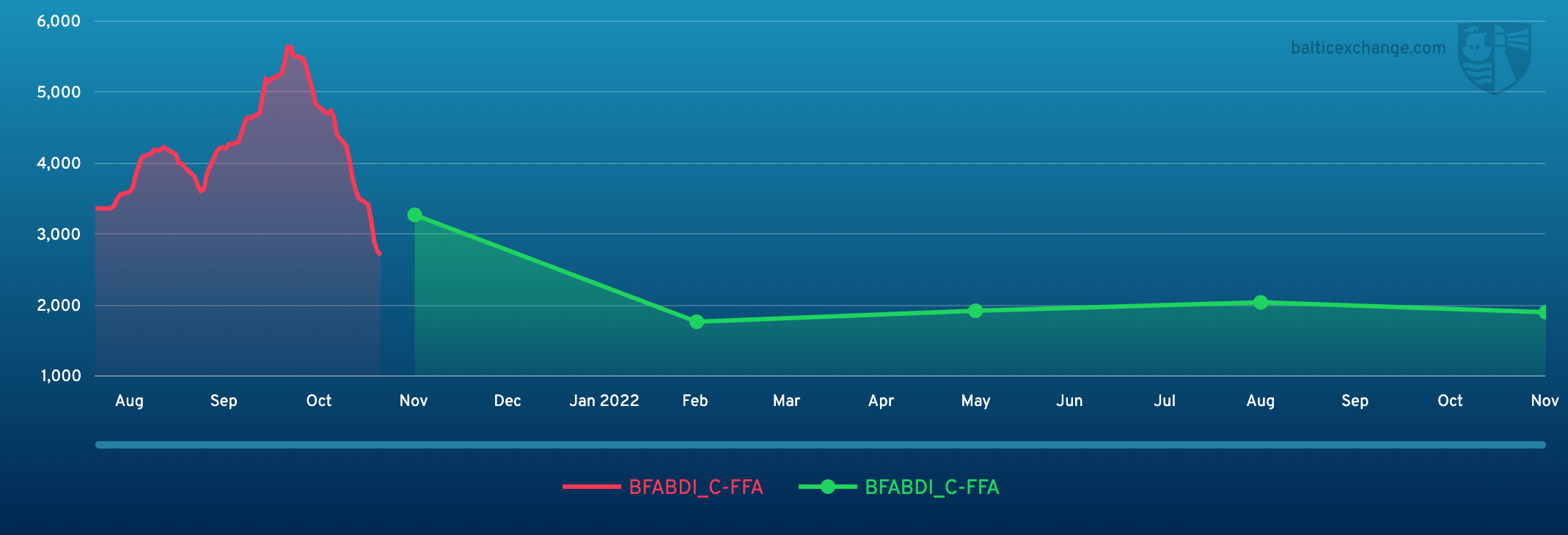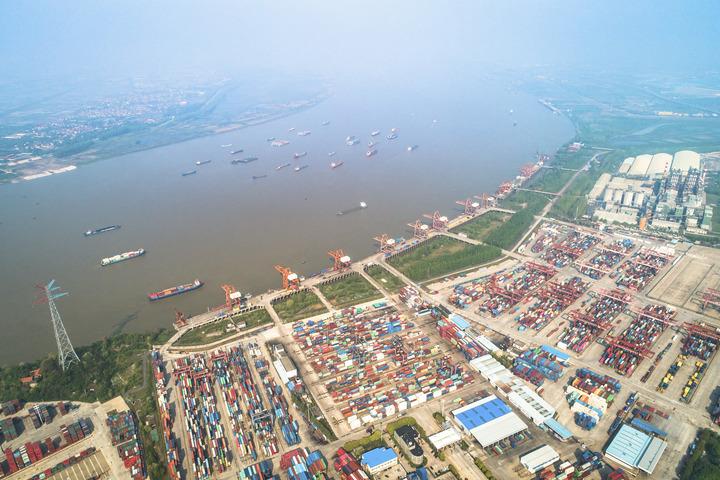BEIJING, Nov. 9 (Xinhua) -- The Baltic Exchange and the FFA Brokers Association (FFABA) are about to host the first major in-person Dry Cargo Forum and Dinner since 2019 in Geneva on Nov.11, according to news release by the Baltic Exchange.
Meanwhile, its weekly report of the dry and tanker markets for Nov.1-5, 2021 are updated as below:
Capesize
The Capesize market has endured another difficult period of sliding rates as the 5TC sustained losses week-on-week of 8,866 to close out at $27,199. On the brighter side, after a month of descent, the Capesize market sentiment closed on a positive note for the week as a firmer footing appeared to form around several routes. Sustainable or not, it will be welcomed by some as a breather. While physical markets weren’t overly busy this week, especially with a public holiday muting Thursday, the same cannot be said of the paper markets as solid fixture volumes were recorded as traders managed positions. The earning spread between basins closed slightly this week as the Transpacific C10 now at $23,987 compares to the Transatlantic at 32,610. However, the Atlantic sentiment has had a not insignificant bump up to close the week. The West Australia to China C5 dipped overall throughout the week yet closed up 0.309 for the weekend at $10.85. The Brazil to China C3 continued its slide throughout the week closing at $24.66. With a little more of Q4 remaining, there is time for more fireworks - although time is running out.
Panamax
Some described the Panamax market as a bloodbath this week with all values seeing massive corrections. The Aussie/Nopac round trips were now traded at levels not seen since Q2 2021 as demand and confidence waned in the basin. Older and less desirable units by end week were now being forced to fix sub $20,000 for the shorter trips. An 81,000dwt delivery Japan agreed a rate of $22,000 for a trip via NoPac redelivery Far East, which again underlined the tone here. The Atlantic, for most part, was seen to be less dramatic in its falls. However, the fall out in the Pacific doubled down on sentiment here too. Despite healthy demand, the Black sea failed to escape the correction with pressure building as ballasters underpinned the market. With a lot of fixing and failing it was difficult to assess accurately where true values stood, but fronthaul fixtures were now regularly agreed at way below $40,000.
Ultramax/Supramax
The rot continued during the week as sentiment across both basins, particularly from Asia, remained low. BSI fell over 774 points week-on-week. Little surfaced on the period front, but a 63,000dwt open Far East was heard fixed for five to seven months at $22,000. In the Atlantic, rates weakened. From the North Atlantic a 57,000dwt open US east coast was fixed for a transatlantic run in the mid $30,000s. Whilst further south, from North Coast South America, an Ultramax fixed a trip to the Continent at around $38,000. From Asia, as coal imports to China slowed tonnage, lists grew across the area. A 61,000dwt open Philippines fixing a trip via Indonesia redelivery China at $19,000. Further North a 61,000dwt open North China fixing a Pacific round in the low $20,000s. It remains to be seen if the week ahead will see any change in direction.
Handysize
This week has seen the BHSI make significant drops, largely due to falling numbers in the Asia markets, where a lack of fresh enquiry has seen the number of spot vessels build. A 28,000dwt open in North Vietnam fixed a trip via Australia to Chennai-Lumut range at $25,750 and a 38,000dwt was rumoured to have fixed a trip from China to the US Gulf at $29,000 earlier in the week. The Atlantic market also saw negative movements with the Black Sea and Mediterranean regions coming under pressure with a 32,000dwt fixing from Canakkale via the Black Sea to Tunisia at $30,000 and a 34,000dwt fixing from Annaba to East Coast South America with fertiliser at $33,000. Brazil has seen more activity with a 38,000dwt fixing from Maceio to Portugal with an intended cargo of sugar at $37,000 and a 39,000dwt fixing from Fortaleza via North Brazil to the US East Coast at $37,500.
VLCC
Rates slipped slightly in both the Middle East Gulf and Atlantic regions. For the 280,000mt Middle East Gulf to US Gulf (Cape/Cape routing) trip rates are assessed half a point less than a week ago, at around the WS22 mark. The rate for 270,000mt Middle East Gulf to China is now 1.5 points, at just under WS45 (a roundtrip TCE of $3.9k/day). In the Atlantic, rates for 260,000mt West Africa to China dipped by a point to WS47 (a TCE of $7.5k/day roundtrip) and 270,000mt US Gulf to China is down $56,250 at $5.5m (a TCE of $9k per day roundtrip).
Suezmax
In West Africa the market was steady with the rate for 130,000mt Nigeria/UK Continent being maintained at just over WS76 (showing a roundtrip TCE of about $9.2k/day). The rate for 135,000mt Black Sea/Med rose two points to the WS87 level (a TCE roundtrip of $9k per day). The Middle East/Mediterranean market was been quiet compared to recent weeks and the rate for 140,000mt Basrah/Lavera is now assessed three points off from a week ago at just below WS45.
Aframax
In the Mediterranean, charterers have been able to take a grip of the market and rates for 80,000mt Ceyhan/Lavera have been reduced by about eight points to the mid-point of the WS127.5/130 region ($17.2k per day TCE roundtrip). Conversely, in Northern Europe, the market for 80,000mt Cross-North Sea has increased by about six points to between WS120/122.5 (a TCE of about $10.1k/day) and 100,000mt Baltic/UK Continent gained four points to nearly WS92.5 (a TCE of about $11.7k per day roundtrip). Across the Atlantic, the market-easing continues with the rate for 70,000mt US Gulf/UK Continent losing another couple of points to around the WS105/107.5 mark (a TCE of $6k/day roundtrip). The 70,000mt Caribbean/US Gulf rate shed about 6.5 points to just below WS132 (a TCE of $11.8k/day roundtrip) and 70,000mt East Coast Mexico/US Gulf is seven points down on last week at WS135 ($14.4k/day TCE roundtrip).
Clean
A mixed bag in the Middle East Gulf this week. On the LR2s TC1 peaked at WS117.5 in midweek then resettled at WS110, a round-trip TCE of $7898/day. The LR1s have held stable by comparison and TC5 55k Middle East Gulf / Japan is down 3.36 points to WS1124.64 a round-trip TCE of $7855/day. The MRs have been under pressure from less activity than previous weeks and 35k Middle East Gulf / East Africa (TC17) is now WS182.08 (-WS 12.92).
The Mediterranean Handy market has seen a freight level delta open up this week based on tonnage situation differing in East vs West Med.TC6 30kt Skikda / Lavera is now at WS 136.31 (- WS 6.94). The LR2s, TC15 80k Mediterranean / Japan have shown a further upside and now sit at $1.9875m.
The Baltic Handy market has seen softening pressure creep in this week, as a result of a growing tonnage list and the weaker MR market. TC9 30k Baltic / UK-Continent is now WS 140 (- WS 12.5)
On the UK-Continent MRs, a buildup of prompt vessels has eroded freight rates this week. TC2 37k UK-Continent / US Atlantic Coast dropped WS17.77 to WS111.67. TC19 37k Amsterdam to Lagos has followed suit and is currently marked at WS114.29 (- WS17.5).
On the LR1s, TC16 60k Amsterdam / Offshore Lome has had encouraging signs with rates pushing up off the back of demand for the vessel size in the Uk-Continent and Mediterranean. The run is now pegged at WS111.43 - up 10.72 points.
In the Americas the MR market has again shown a consistently firming sentiment this week. TC14 38k US Gulf / UK-Continent jumped to WS 128.93 (+WS 27.5) and TC18 38k from US Gulf / Brazil surged 40 points to WS183.21.
Headquartered in London and a subsidiary of the Singapore Exchange (SGX), the Baltic Exchange publishes a range of indices and assessments which provide an accurate and independent benchmark of the cost of transporting commodities and goods by sea. These include the Baltic Dry Index (BDI), the dry bulk shipping industry's best known indicator. Published daily since 1985, this provides a snapshot of the daily spot market earnings of capesize, panamax and supramax vessel types on the world's key trading routes.

Chart shows Baltic Dry Index (BDI) during Nov.5, 2020 to Nov.5, 2021

Baltic Forward Assessment for BDI
In March 2018 the BDI was re-weighted and is published using the following ratios of time charter assessments: 40 percent capesize, 30 percent panamax and 30 percent supramax. The information is provided by a panel of international shipbrokers.
(Source: The Baltic Exchange, edited by Niu Huizhe with Xinhua Silk Road, niuhuizhe@xinhua.org)




 A single purchase
A single purchase









